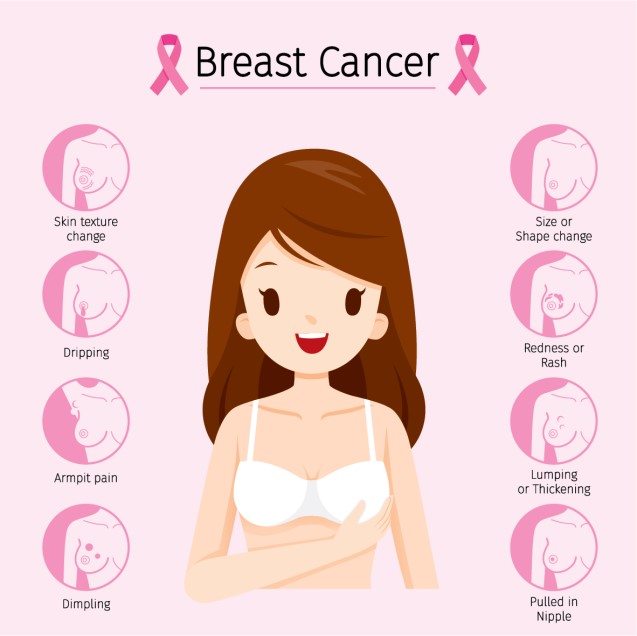By Sonia Okere
It was a cold night, and Jessica had just finished a long shift at the mall, where she worked as a cleaner. On her way home, she called her daughter to prepare a delicious dinner for her.
The only thing on her mind was to eat and sleep like a baby. But when she walked through the door of her small, cosy home, she met the worried faces of her husband and two children.
“Baby, is everything okay?” She asked her husband.
“Sweetheart, we have to talk, but that would be after you have eaten.” He responded.
One hour later, while everyone was seated in the parlour, Jessica’s husband broke the sad news to her.
“We received your mammogram results, and unfortunately, you have breast cancer.”
“Please tell me this is a prank.” She spoke with a shaky voice.
“I’m sorry, dear, but it is the truth.”
Jessica was shocked to the bone when she saw the results. She had always been vigilant about her health, getting regular check-ups and mammograms as recommended. She had never even considered the possibility that she might be diagnosed with breast cancer.
It all started when she noticed a small lump in her breast. She initially ignored it, hoping it was just a benign cyst or something else that wasn’t serious. But as the weeks passed, the lump grew larger, and she decided to see a doctor.
After they confirmed the diagnosis, Jessica visited the hospital frequently for tests and treatments. The doctors told her that the cancer was aggressive and that she needed chemotherapy and surgery to control it. My dear friend underwent five chemotherapy courses, and each of them cost over N200, 000. She also had to purchase drugs and pay for other medical expenses.
In layman’s language, chemotherapy is simply the act of injecting poison into the body to kill the cancerous cells. However, in the process, other healthy cells die too. Meanwhile, Jessica had always been a strong and resilient woman, but the chemotherapy took a heavy toll on her body. She lost her hair, appetite, and energy. She was in constant pain, and her medication made her sick to her stomach.
While praying for a quick recovery, she also prayed for financial provision. Her family had spent a fortune on her treatment, yet the bills kept accumulating. They even sold some of their property and took out loans. After the first surgery, they felt the worst days were already behind them, but Jessica grew weaker and weaker as the months passed. The cancer had already spread to other parts of her body. She endured the pain for four years and fought hard to regain her health. Sadly, at the end of it all, she lost the battle. Jessica passed away and left a hole in the hearts of her loved ones.
What is breast cancer?
It is a type of cancer that occurs in the breast cells. According to the World Health Organization, breast cancer is the most common cancer among women in Nigeria, accounting for about 30% of all cancer cases in women. The incidence of breast cancer in Nigeria is increasing, with an estimated 14,000 new cases and 8,000 deaths occurring each year.
Although every woman is prone to breast cancer, several risk factors can increase the chances of developing it. Some examples include:
Age: Breast cancer is more common in women over the age of 50.
Family history: If a person has a family member (such as a mother, sister, or grandmother) who has had breast cancer, their risk may be higher.
Personal history: Women who have previously had breast cancer or certain non-cancerous breast conditions have an increased risk of developing the disease again.
Reproductive and menstrual histories: Factors such as starting menstruation at a young age, going through menopause at an older age, never giving birth or having a first child after age 30 may increase the risk of breast cancer.
Continuous use of hormonal supplements: Using hormone replacement therapy (HRT) or taking certain birth control pills may increase the risk of breast cancer.
Exposure to radiation: Women exposed to radiation have an increased risk of developing breast cancer.
Kindly note that having one (or more) of these risk factors does not guarantee that a person will develop breast cancer. On the other hand, many people who develop the disease do not have any known risk factors.
Types of Breast Cancer
There are several types of breast cancer, and some are more aggressive than others. Here are a few examples:
Inflammatory breast cancer: This rare and aggressive type of breast cancer accounts for about 1-5% of all cases. It is characterised by swelling, redness, and warmth of the breast and can often be mistaken for an infection.
HER2-positive breast cancer: It is characterised by the presence of the human epidermal growth factor receptor 2 (HER2) protein, which helps cancer cells grow and multiply. Approximately 20% of breast cancers are HER2-positive, and they have excess copies of the gene that produces the HER2 protein. This type of cancer is generally more aggressive than others.
Triple-negative breast cancer: In this case, the cancer cells lack estrogen receptors, progesterone receptors, and the HER2 protein. It tends to be more aggressive and more likely to recur than other types of breast cancer.
The stages of breast cancer range from 0 to IV, with stage 0 being the earliest and stage IV being the most advanced. These different stages are based on the size of the tumour, the presence or absence of cancer cells in the lymph nodes, and whether the cancer has spread (metastasized) to other parts of the body. Moreover, the stages do not necessarily reflect the severity of the cancer. I have seen many people with advanced-stage breast cancer who were treated successfully.
During the early stages of breast cancer, there may be no signs. However, as the cancerous cells grow and multiply, the following symptoms might be seen:
• A lump or thickening in the breast or underarm (axilla) region.
• Changes in the size, shape, or appearance of the breast, such as dimpling, puckering, or changes in the nipple.
• Discharge from the nipple.
• Swelling, redness, or warmth in the breast or underarm region.
• Persistent pain or discomfort in the breast or underarm region.
Benign (non-cancerous) conditions can also cause these symptoms. However, if you notice any changes in your body, consult a healthcare provider to evaluate your symptoms.
Breast cancer is usually diagnosed through a combination of physical examination, mammography, and biopsy. A mammogram is an X-ray of the breast that can help to identify abnormalities that may be cancerous. A biopsy involves testing a small sample of tissue in the laboratory to confirm the presence of cancer.
If breast cancer is suspected based on mammogram or physical examination results, a healthcare provider may recommend additional testing, such as a biopsy, to confirm the diagnosis.
How to Perform a Simple Breast Cancer Examination at Home

Stand in front of a mirror with your arms at your sides. Touch your breast and look for changes in size, shape, or appearance.
Raise your arms above your head and look for the same changes. Check the nipple too.
Lie down on your back with a pillow under your right shoulder. Using the pads of your fingers, move in a circular pattern around your right breast, starting at the outer edge and moving inward. Be sure to cover the entire breast, including the armpit area.
Repeat the process on your left breast.
Stand or sit comfortably, then squeeze each nipple gently between your thumb and forefinger. Look for any discharge or changes in the nipple.
Tip:
Most breast lumps are benign (non-cancerous) and are caused by factors such as hormonal or fibrocystic changes. However, breast cancer lumps may feel like a hard knot or thickening in the breast or underarm. Sometimes, the lumps may be painless, moveable within the breast or underarm (axilla) region, or fixed to the surrounding tissue.
Always perform a breast self-examination at the same time each month so you can become familiar with your breast shape, structure, size, and lump.
Metastatic Breast Cancer:
Breast cancer can spread (metastasize) to other body parts through the bloodstream or lymphatic system. When the bones, liver, lungs, or brain get damaged, it can lead to life-threatening complications.
Not all breast cancers spread. There are some factors that contribute to that. However, the risk of spreading is reduced if it is detected and treated early.
General Tips on Breast Cancer Prevention

The bitter truth is that there is no 100% tested and trusted method to prevent breast cancer. However, there are several steps you can take to reduce your vulnerability. Some examples are:
Maintain a healthy weight: Being overweight, particularly after menopause, may increase the risk of breast cancer. Therefore, always maintain a healthy weight.
Don’t fail to exercise your muscles: Regular exercise reduces your risk of developing breast cancer, probably because it lowers the levels of insulin, hormones, and growth factors in your body. Don’t be lazy. You can use a few minutes to perform moderate-intensity or vigorous-intensity exercise every week.
Avoid harmful habits: Say no to excessive alcohol intake. If you are a smoker, quit as soon as possible.
Rest and sleep: Always get enough sleep, at least 7-9 hours each night.
Reduce the intake of certain foods: Some studies have suggested that a high intake of high-fat dairy products, sugar-sweetened beverages, fried foods, and processed meat may be associated with an increased risk of breast cancer.
Breastfeed as long as you can: According to Cancer Research UK, exclusive breastfeeding for at least six months can decrease the risk of breast cancer, especially if done when the mother is younger. So, I would advise you to always breastfeed as long as possible.
The Challenges of Living with Breast Cancer

According to a study by Jin et al. (2021), approximately 76.7% of breast cancer survivors reported moderate levels of stigmatization, and 8.7% reported high levels of stigmatization.
As if the physical pain of chemotherapy and surgery wasn’t enough, Samantha, a breast cancer survivor, also had to endure the emotional pain of being ostracized by the people she loved. Some of her family members became distant, and even her closest friends stopped inviting her to social gatherings. So she struggled to find someone who would understand what she was going through.
As the nights became darker, Samantha was determined to beat the disease. She found strength in online support groups and eventually connected with other survivors who had faced similar stigma. With their help, she rebuilt her confidence and found the courage to speak out about her experience.
Most people believe breast cancer is a contagious disease, which is why they stigmatize those living with it. Another reason for stigmatization is the societal association of cancer with death. I think it’s high time we addressed all the misconceptions about breast cancer.
In the case of Mrs Oluwagbamila, she felt the battle was over after undergoing surgery to remove her right breast. However, a year later, she discovered another cancerous lump had grown in the same spot as the original one.
When she got the report, she was heartbroken. She told her children that she would die and urged them to care for each other after she was gone. However, amid the stormy waters, her husband assured her that she would not die. He even quit his job in Lagos to be with her in Akure. He also offered her constant love and support. According to her, the support she got from her family actually cushioned her pain.
Breast cancer report is not a death sentence
Did you know that a positive breast cancer report is not a death sentence? According to Cancer Research UK, almost 8 out of 10 women diagnosed with breast cancer are predicted to survive their disease for at least ten years. There are some factors that can affect the survival rate. They include; the stage (extent) of the cancer at the time of diagnosis, the type of cancer, the individual’s age and overall health, and the effectiveness of the treatment.
Let’s talk about the cost of treatment. Did you know that some chemotherapy sessions cost over N300,000? How many poor women in Nigeria can afford such medical expenses? Unfortunately, most patients have died due to a lack of funds for treatment. Additionally, we still lack good medical facilities and treatment services. That is why the rate of death keeps increasing.
So what is the way forward? Early detection is a significant key to the successful treatment of breast cancer. By raising awareness of the importance of self-exams and mammograms, more people may be motivated to get screened, which can lead to earlier detection.
Finally, I want you to be strong and hopeful if you have breast cancer. Don’t wallow in self-pity. There are several organizations in Nigeria that are working to improve access to screening and treatment services.
Look for them and ask for help. Although this might be a challenging phase of your life, I believe that the same God who helped other cancer survivors will also see you through. So, don’t give up, because better days will come.


